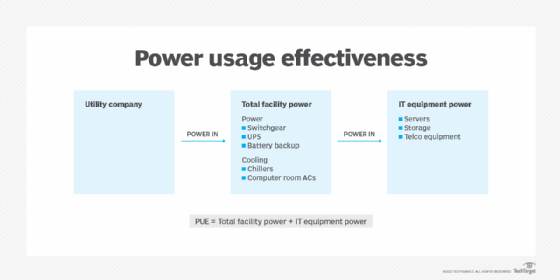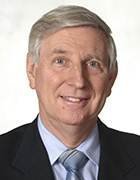power usage effectiveness (PUE) (original) (raw)
What is power usage effectiveness (PUE)?
Power usage effectiveness (PUE) is a metric used to determine the energy efficiency of a data center. PUE is determined by dividing the total amount of power entering a data center by the power used to run the IT equipment within it. PUE is expressed as a ratio, with overall efficiency improving as the quotient decreases toward 1.0.
Data center infrastructure and the processing power within it require a lot of energy, and data centers that do not operate efficiently will use more energy. Monitoring a metric like PUE is useful for benchmarking data center efficiency. Organizations and data center managers can use this metric once to measure their data center efficiency and then again to measure the effect of any changes made to the data center. This helps reduce power consumption and energy costs.
PUE was created by members of the Green Grid, an industry group focused on data center energy efficiency. According to the "Uptime Institute Annual Global Data Center Survey 2021," PUE and power consumption are among the top tracked sustainability methods. A similar benchmarking standard recognized by the Green Grid is Data Center Infrastructure Efficiency, or DCiE.

How PUE is calculated, including examples of what sort of equipment is measured in each part of the equation.
How is PUE calculated?
The calculation of power usage effectiveness is total facility power/IT equipment energy = PUE. Total facility power is the amount of power the facility uses, which includes all data center hardware, power delivery components, cooling systems and lighting systems. IT equipment energy refers to the amount of energy that is used to power the storage and networking equipment as well as control equipment such as monitors and workstations.
PUE can be calculated using the following steps:
- Measure energy use at the facility's utility meter. If the data center is in a mixed-use facility or office building, take a measurement only at the meter that is powering the data center. If it is not on a separate utility meter, estimate the amount of power being consumed by the non-data center portion of the building and remove it from the equation. A better way of doing this, however, is by using data center infrastructure management (DCIM) software. Instead of taking a trip to the utility meter and making an estimation, sensors are installed that collect real-time energy usage data for measuring PUE.
- Measure the IT equipment load after power conversion, switching and conditioning are completed. The most useful measurement point is at the power distribution units, which supply power to the computers and networking equipment. This measurement should represent the total power delivered to the server racks in the data center.
- Do the math. Once the measurements are collected, calculating PUE is just dividing total facility power by equipment energy.
Benefits and limitations of PUE
Benefits of power usage effectiveness include the following:
- Calculation can be repeated. The metric is meant to be used multiple times to gauge changes in data center efficiency.
- Gauge more efficient practices. The metric can help identify effective and noneffective ways to reduce energy usage.
- Pairs with DCIM software. DCIM software can automatically calculate PUE in real time, consolidating that data into reports.
- The PUE metric in competition. Organizations with good PUE ratios can use their score in marketing materials.
Some example limitations involved with data center PUE, however, include the following:
- Calculating the accurate total facility power. Accuracy of the total facility power calculation is a major factor affecting the measurement of PUE. If an organization has to estimate that number at its utility meter, then the resulting calculation is only an estimation.
- PUE does not capture consumption at the rack level. Energy that is consumed at the rack level is not part of the overall PUE calculation, making the PUE less accurate.
- PUE as a marketing metric. Although organizations can use PUE in marketing, the metric is meant to be used as an improvement and assessment metric. Marketers should not rely heavily on PUE just because it may be a widely understood concept.
How can you lower PUE?
Steps to take in order to lower a power usage effectiveness ratio closer to 1.0 include the following:
- Virtualize servers. Virtual machines can run their own workloads, which reduces energy consumption and frees up more floor space.
- Improve cooling systems. To prevent overheating, data centers require a cooling system. However, refrigerant-based cooling systems use a lot of power. Improving these systems or reducing the data center's reliance on them can help lower PUE.
- Optimize cool air production. This can be done, for example, by using naturally cool outside air or heat exchangers.
- Replace inefficient hardware. The quality and performance of some hardware may degrade over time, so if servers or storage systems are not performing properly, they should be replaced.
- Use an energy-efficient uninterruptible power supply (UPS ). Power distribution should be designed with a UPS to be more efficient. More efficient equipment and making power run a shorter distance increase efficiency.
- Use energy-efficient lighting. Although lighting generally makes up a smaller portion of power consumption, it is still an easy way to reduce power and heat production. Replacing fluorescent lighting with LEDs on motion sensors and lighting controls can help reduce power consumption and heat production.
Learn about more ways to reduce data center power consumption, including reducing CPU demands and addressing more cooling-related costs in this article.
This was last updated in April 2022
Continue Reading About power usage effectiveness (PUE)
- Streamline data center power usage tracking with DCIM
- 6 DCIM software vendor tools address data center complexities
- Recent data center advancements include AI, new CPUs
- An introduction to DCIM software metrics and terms
- A mechanical refrigeration system primer for admins
Dig Deeper on Data center ops, monitoring and management
-
 Understand the power usage effectiveness metric
Understand the power usage effectiveness metric  By: Robert McFarlane
By: Robert McFarlane -
 How to design and build a data center
How to design and build a data center  By: Stephen Bigelow
By: Stephen Bigelow -
 Datacentres’ energy-efficiency investment priorities in the race to net zero
Datacentres’ energy-efficiency investment priorities in the race to net zero  By: Fleur Doidge
By: Fleur Doidge -
 Uptime’s annual datacentre market poll highlights industry’s sustainability reporting gaps
Uptime’s annual datacentre market poll highlights industry’s sustainability reporting gaps By: Caroline Donnelly